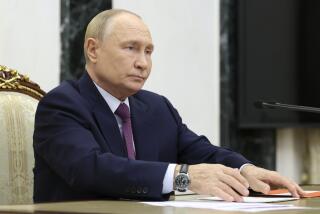COLUMN RIGHT : Bush’s Moves Reduce Risk of Nuclear War : But bomber stand-down is a mistake, and accepting call for a test ban would be another.
- Share via
President Bush’s decision to substantially alter the U.S. nuclear posture contains elements that will be highly beneficial in reducing the risk of nuclear war, others of minor importance and one that will do more damage than good.
The primary benefits of the President’s decision result from the changes in nonstrategic nuclear forces, as long as those changes are reciprocated by the Soviet Union. Among these changes, the most important is the withdrawal of weapons currently based on ships and submarines, including sea-launched cruise missiles (SLCMs).
SLCMs are small, low-flying missiles that are very difficult to detect with early-warning radars. Deployed on Soviet submarines off our Atlantic coast, they could pose the threat of a surprise attack against Washington and key facilities controlling our retaliatory forces, thus undermining deterrence. (Because of geographical and other differences, American SLCMs do not pose the same threat to the Soviet Union.) The Soviets’ withdrawal of their nuclear SLCMs would eliminate this potentially destabilizing threat.
Bush’s changes in our strategic posture are more modest, as will be their effects. His cancellation of three modernization programs is merely a recognition of reality; the rail-based MX missile had been killed in Congress, the mobile Midgetman was unlikely to receive congressional funding, and the short-range attack missile had severe technical problems.
The most potentially beneficial step in the strategic area is Bush’s proposal for early U.S.-Soviet agreement on the elimination of intercontinental ballistic missiles with multiple warheads. These missiles, which are both vulnerable to attack and highly attractive as targets, provide each side with an incentive to strike the other first and force both to take dangerous countermeasures to protect these weapons. Their mutual elimination would therefore strengthen both deterrence and safety.
This one provision should not be the only focus of early negotiations, however. The United States should seek a comprehensive package of improvements to the strategic balance created by the recently signed START treaty.
Among these provisions should be bans on new threats to the survival of our forces, such as earth-penetrating warheads, maneuvering re-entry vehicles and large, special-function nuclear warheads; requirements that both sides destroy all missiles included in the reductions rather than placing some in storage; verification improvements and, of course, further reductions in overall force levels.
The element of Bush’s initiative that I regret is the decision to have our strategic bombers stand down from their alert posture. This will mean that our entire bomber force will be vulnerable to a Soviet surprise attack. Although such an attack is extremely unlikely, I nevertheless do not believe we should be taking steps that increase the incentive for the Soviets to conduct one.
The key to the benefits expected to result from Bush’s decision is, of course, that the Soviets will reciprocate the changes in the U.S. force posture. Are they likely to do so? I believe they are. They are just as concerned as we about the security of nonstrategic nuclear forces and probably just as skeptical about their remaining utility. They therefore should jump at the chance to eliminate this mutual headache.
Given their economic difficulties, they are also likely to welcome the opportunity to cut back on the modernization of strategic forces. And leaders in Moscow and the republics have already indicated a desire to move quickly toward deeper reductions in strategic forces. The Soviets will, no doubt, add their own twist when they respond, but the general thrust seems likely to be similar to Bush’s.
One key difference on the Soviet side is the renewed call for a comprehensive nuclear test ban. This is a step the Bush Administration should continue to resist. As long as we rely on nuclear weapons for our ultimate deterrent of war, we must be confident that they will work and we must do sufficient testing to maintain that confidence. Restrictions beyond the current limits on testing, such as a yearly quota, may be possible, but a complete ban goes too far.
In sum, despite one misstep, President Bush has taken an important leap forward toward creating a safer world. It is time now for him to take the next important step by initiating early talks on a comprehensive package of provisions that will go beyond the START treaty in creating a more stable strategic balance.
More to Read
Sign up for Essential California
The most important California stories and recommendations in your inbox every morning.
You may occasionally receive promotional content from the Los Angeles Times.












